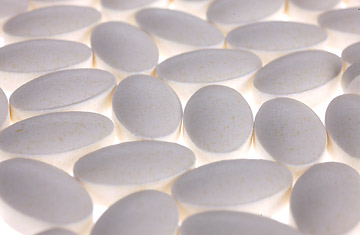
Sometimes too much of a good thing can be ... not such a good thing. That's the conclusion of the largest study to date of the effects of giving superdoses of vitamin D. The supplement helps bodies build bone and muscle, but the new study, published this week in the Journal of the American Medical Association (JAMA), finds that megaquantities of the vitamin — a year's supply given in an single dose, for instance — do not appear to reduce the risk of falling or suffering fractures in elderly women.
Most adults in developed nations, including the U.S., are vitamin D deficient, in large part because of lack of sun exposure. While the body naturally produces vitamin D when the skin is exposed to ultraviolet rays, concerns about skin cancer and the heavy use of sunscreens have contributed to a worrying deficiency in large populations. That's why researchers continue to study the most effective dosing regimen for vitamin D supplementation, particularly in the elderly who are at increased risk for falls and fractures, which are a major cause of death.
Encouraged by previous studies showing that 500,000 IU of vitamin D, given over multiple doses over a short period of time, and a single injection of 300,000 IU improved balance and strength and reduced fractures, Australian scientists at the University of Melbourne expected that a walloping single oral dose of 500,000 IU would also be effective. The study, led by Geoffrey Nicholson and Kerrie Sanders, involved 2,256 women, ages 70 years or older, who were considered to be at high risk of fracture. They were randomly assigned to receive 500,000 IU of cholecalciferol (a form of vitamin D) or placebo once a year for up to 5 years.
To the researchers' surprise, women who received vitamin D actually suffered more falls and fractures than women who got the placebo pill. The trial participants experienced a total of 5,404 falls over the course of the study; compared with the placebo group, women taking the vitamin D megadose experienced 15% more falls and 26% more fractures.
Although women in the treatment group did have higher blood levels of vitamin D throughout the year than their placebo-taking counterparts, the added vitamin offered no protection again broken bones. "People have been exploring what is the upper limit of dosing that can be given," says Nicholson, head of the department of clinical and biomedical sciences at the University of Melbourne. "And I think we inadvertently exceeded it. I think the take home message is that megadoses are not safe; that's certainly going to be our approach until we have evidence to the contrary."
It's not entirely clear why the superdosing had the opposite of its intended effect, but animal studies provide some clues. In rats, for example, there is evidence that the body may perceive the sudden influx of vitamin D as a foreign substance, not unlike a pathogen such as a virus or bacteria. In these animals, the enzyme responsible for breaking down vitamin D kicks into overdrive, in a frantic effort to rid the body of what it believes to be a toxin. Ultimately, this enzyme may do its job too well, converting active forms of the vitamin in tissues such as bone and muscle into inactive forms, and leaving the body vitamin D deficient.
"The byproduct of that overactive enzyme is that the level of active metabolite of vitamin D actually declines," says Dr. Bess Dawson-Hughes, director of the bone metabolism laboratory at the USDA Nutrition Center at Tufts University. Dawson-Hughes co-authored an editorial accompanying the JAMA study in which she speculates about how such high doses of vitamin D are treated in the body. "The results of this study remind us that we need to understand these sorts of things better in order to efficiently get to the optimum dosing regimen," she says.
But she also says she is not entirely discouraged by the Australian study's findings; she suspects that if a single megadose of vitamin D didn't work, additional studies could still show that the same amount — 500,000 IU — given in smaller doses over a longer period may prove protective against falls and fractures.
For now, however, the results are enough to "chill my enthusiasm," Dawson-Hughes says, of treating severe vitamin D deficiencies with a heavy load of the vitamin — which is the current standard practice. In some patients who have inherited D deficiencies, doctors may treat them with about 50,000 IU orally twice a week for up to eight weeks, in order to bring their blood levels of the vitamin up to about 1,000 IU per day. But in light of the current study results, she says, and the lack of hard evidence that such loading regimens are effective, "I think I will defer on loading to treat severe deficiencies," she says.
What may work better is the standard dosing advice that applies to the 75% of American adults and teens whose vitamin D levels are below government recommendations: smaller, more frequent doses of the vitamin in pill form (no more than 2,000 IU daily), or getting up to 10 minutes of daily sun exposure to meet the body's needs of 800 to 1,000 IU a day.
It wasn't the recommendation that the study authors had anticipated, or hoped for: doctors would prefer to give a large, single dose of vitamin D to reduce falls and fractures in the elderly, because more frequent regimens — taking daily, weekly or monthly supplements — usually have a low compliance rate in this group. But at least, says Nicholson, the results are "useful in actually defining that the megadosing regime is unsafe, and that high annual doses need to be considered with some caution."
